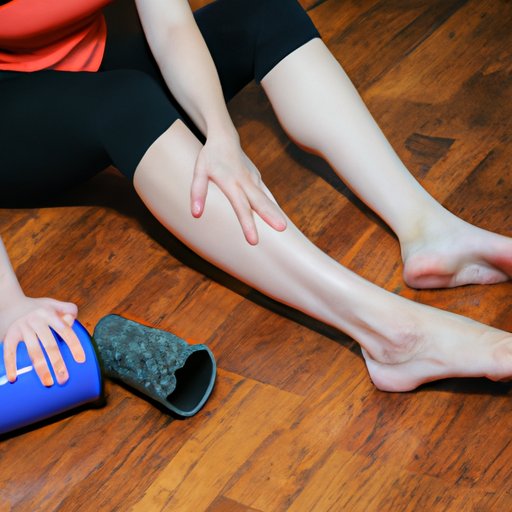Introduction
Sore muscles are an all-too-familiar feeling that comes after a tough workout. This feeling is caused by muscle strain, which happens when the fibers in the muscle are stretched or torn due to physical activity. While it can be uncomfortable, it is also a sign that your body is adapting and growing stronger. In this article, we will explore ways to ease the pain of sore muscles after a workout, as well as strategies for preventing soreness in the first place.

Tips for Easing Sore Muscles After a Workout
The most important thing you can do after a workout is to rest. Take a break from strenuous activity and give your body time to recover. Additionally, cooling down after a workout can help reduce soreness. Start with some light activity such as a slow jog or walk, then gradually decrease the intensity until you’re no longer moving.
Staying hydrated is also essential for reducing soreness. Drink plenty of water before, during, and after your workout to keep your muscles hydrated and functioning at their best. Eating protein-rich foods like lean meats, fish, eggs, and nuts can also help with post-workout soreness and repair muscle damage.
Finally, light stretching after your workout can help reduce soreness. Aim for dynamic stretching, which is a type of stretching that involves active movement, rather than static stretching, which involves holding a stretch for a period of time.

How to Work Out Sore Muscles and Feel Better Quickly
If your muscles are already sore, there are several things you can do to help alleviate the pain. Gentle exercise, such as walking or swimming, can help loosen tight muscles and get your blood flowing. Massage or foam rolling can also help loosen up tight muscles and improve circulation. Heat or cold therapy can also be beneficial; heat helps relax tense muscles while cold reduces inflammation.
The Best Stretches for Working Out Sore Muscles
When stretching a sore muscle, it’s important to use the right type of stretching. Dynamic stretching is best for loosening up tight muscles and increasing range of motion. This type of stretching involves active movements, such as leg swings, arm circles, and torso twists. Static stretching is another good option; this type of stretching involves holding a stretch for a period of time. Finally, isometric stretching is a type of stretching that involves contracting and releasing a muscle group. Examples include wall sits, planks, and isometric holds.
Is Ice or Heat Better for Sore Muscles After Exercise?
Both ice and heat can be used to relieve sore muscles after a workout. Applying ice to a sore muscle can help reduce inflammation and numb the area, making it easier to move. Heat, on the other hand, helps relax tense muscles and increase circulation, which can speed up recovery time.

Home Remedies for Sore Muscles After Working Out
There are many home remedies that can help ease sore muscles after a workout. Epsom salt baths are a great way to reduce inflammation and relax tight muscles. Herbal teas, such as chamomile and ginger tea, can also help soothe sore muscles. Finally, essential oils, such as lavender and peppermint, can be used to reduce pain and inflammation.
Conclusion
In conclusion, sore muscles after a workout can be painful and uncomfortable. Resting and cooling down after a workout, staying hydrated, eating protein-rich foods, and light stretching can all help reduce soreness. Additionally, gentle exercise, massage or foam rolling, heat or cold therapy, and the right type of stretching can help ease the pain of sore muscles. Finally, home remedies like Epsom salt baths, herbal teas, and essential oils can provide relief from sore muscles. To prevent soreness in the first place, make sure to warm up properly before a workout and cool down afterwards.
(Note: Is this article not meeting your expectations? Do you have knowledge or insights to share? Unlock new opportunities and expand your reach by joining our authors team. Click Registration to join us and share your expertise with our readers.)
